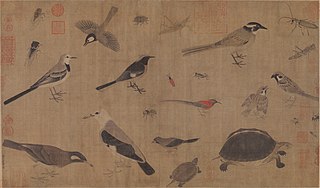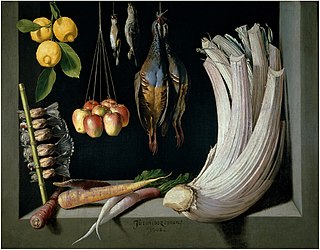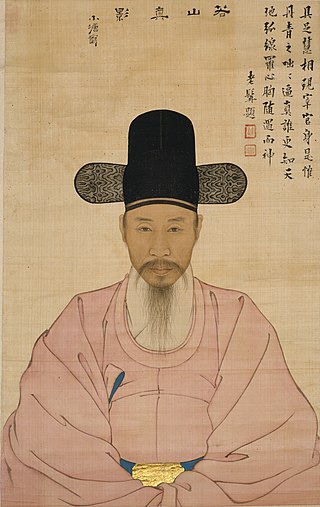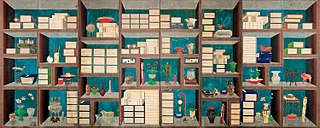- Hwanjogujado (picture of puppies and flowers, birds)
- Cat
- Gammo yeojaedo (감모여제도 感慕如在圖)
- Tiger
- Magpie and tiger
- Eohado (picture of fish and crabs)
- Hwajodo (flowers and birds)
- Jangsaeng hwarakdo
- Munjado
- Munjado
Related Research Articles

Chinese painting is one of the oldest continuous artistic traditions in the world. Painting in the traditional style is known today in Chinese as guó huà, meaning "national painting" or "native painting", as opposed to Western styles of art which became popular in China in the 20th century. It is also called danqing. Traditional painting involves essentially the same techniques as calligraphy and is done with a brush dipped in black ink or coloured pigments; oils are not used. As with calligraphy, the most popular materials on which paintings are made are paper and silk. The finished work can be mounted on scrolls, such as hanging scrolls or handscrolls. Traditional painting can also be done on album sheets, walls, lacquerware, folding screens, and other media.

A still life is a work of art depicting mostly inanimate subject matter, typically commonplace objects which are either natural or human-made.

A mandarin square, also known as a rank badge, was a large embroidered badge sewn onto the surcoat of officials in Imperial China, Korea, in Vietnam, and the Ryukyu Kingdom. It was embroidered with detailed, colourful animal or bird insignia indicating the rank of the official wearing it. Despite its name, the mandarin square falls into two categories: round buzi and square buzi. Clothing decorated with buzi is known as bufu in China. In the 21st century, the use of buzi on hanfu was revived following the Hanfu movement.

Stories and practices that are considered part of Korean folklore go back several thousand years. These tales derive from a variety of origins, including Shamanism, Confucianism, Buddhism, and more recently Christianity.

Korean arts include traditions in calligraphy, music, painting and pottery, often marked by the use of natural forms, surface decoration and bold colors or sounds.

Korean embroidery techniques and artifacts have a long history, but there is the most evidence from the Joseon Dynasty, after the 14th century in Korea. This article talks about the history, styles, preservation, artists, and examples of screens, costumes, and domestic wares of this exacting and beautiful art form.

Korean painting (Korean: 한국화) includes paintings made in Korea or by overseas Koreans on all surfaces. The earliest surviving Korean paintings are murals in the Goguryeo tombs, of which considerable numbers survive, the oldest from some 2,000 years ago, with varied scenes including dancers, hunting and spirits. It has been hypothesized the Takamatsuzuka Tomb in Japan, from the 7th-century end of the Goguryeo period, has paintings with Goguryeo influence, either done by Goguryeo artists, or Japanese one trained by Goguryeo people. Since a lot of influences came into the Korean peninsula from China during the Three Kingdoms period. Until the Joseon dynasty the primary influences came from Chinese painting though done with Korean landscapes, facial features, Buddhist topics, and an emphasis on celestial observation in keeping with the rapid development of Korean astronomy.

Taoism or "Do" is thought to be the earliest state philosophy for the Korean people. However, its influence waned with the introduction of Buddhism during the Goryeo kingdom as the national religion and the dominance of neo-Confucianism during the Joseon dynasty. Despite its diminished influence during those periods, it permeated all strata of the Korean populace, integrating with its native animism as well as Buddhist and Confucian institutions, temples, and ceremonies. The Taoist practice in Korea developed, somewhat in contrast to China, as an esoteric meditative practice in the mountains taught by the "mountain masters" or "mountain sages".

Itō Jakuchū was a Japanese painter of the mid-Edo period when Japan had isolated itself from the outside world. Many of his paintings concern traditionally Japanese subjects, particularly chickens and other birds. Many of his otherwise traditional works display a great degree of experimentation with perspective, and with other very modern stylistic elements.

The Piling School was a genre of Chinese painting, named for its place of origin, now Changzhou in Jiangsu province. The style was influenced by contact with Japan, and examples are found almost exclusively in Japan and particularly in collections associated with the great Japanese Buddhist monasteries.

Dancheong refers to Korean decorative colouring on wooden buildings and artifacts for the purpose of style. It is an adaptation of the Chinese practice danqing, although danqing refers to Chinese painting on silk or paper rather than decoration on wood. It literally means "cinnabar and blue-green", and is sometimes translated as "red and blue" in English. Along with its decorations and the choice of paint colours, Dancheong carries various symbolic meanings. It is based on five basic colours; blue (east), white (west), red (south), black (north), and yellow (center). The use of those five colours reflected the use of the yin and yang principle and the philosophy of the five elements.
Qingyang sachet, also known as "chu chu" or "shua huo" is a folk custom of Qingyang, Gansu, China. Sachets are created from small pieces of silk, which are embroidered with colorful strings in a variety of patterns according to papercutting designs. The silk is then sewn into different shapes and filled with cotton and spices. Qingyang sachets symbolize blessing, auspiciousness, happiness, safety, peace, and avoidance of evil, disaster, illnesses, and misfortune. Many sachets are also filled with cinnabar, calamus, wormwood, and chrysanthemum, and they are commonly used as air fresheners, insect repellent, and protection against evil spirits.

Cranes are an important motif in Chinese mythology. There are various myths involving cranes, and in Chinese mythology cranes are generally symbolically connected with the idea of longevity. In China, the crane mythology is associated with the divine bird worship in the animal totemism; cranes have a spiritual meaning where they are a form of divine bird which travels between heaven and man's world. Cranes regularly appear in Chinese arts such as paintings, tapestry, and decorative arts; they are also often depicted carrying the souls of the deceased to heaven. The crane is the second most important bird after the fenghuang, the symbol of the empress, in China.
Traditional Korean patterns are often featured throughout Korea on architecture, clothes, porcelain, necessities, and more. These patterns can be recognized either by one of the four time periods they originated from, or by their shape.

A Vase of Flowers is a 1716 floral painting by the Dutch painter Margaretha Haverman. It is in the collection of the Metropolitan Museum of Art.

Golden Cock and Hen is a painting from Korea’s Joseon dynastic period. The painting, which belongs to the early 19th century, was painted by an unknown artist. The painting itself measures about 114.3 cm in height and 45.7 cm in width. With the decorative elements, the complete painting measures 200.7 cm in height and 62.9 cm in width. This painting represents a combination of two established themes of Korean painting: birds and flowers. Also it consists of ten symbols of longevity—the sun, mountains eater, rocks, clouds, pine trees, turtles, cranes, deer and mushrooms. In the central scene, there is a cock and hens perched on a tree and a rock respectively. This represents fortune and future. Currently, the painting is in the Metropolitan Museum of Art, New York, United States.

Chaekgeori, translated as "books and things", is a genre of still-life painting from the Joseon period of Korea that features books as the dominant subject. The chaekgeori tradition flourished from the second half of the 18th century to the first half of the 20th century and was enjoyed by all members of the population, from the king to the commoners, revealing the infatuation with books and learning in Korean culture.

Tigers have had symbolic significance in many different cultures. They are considered one of the charismatic megafauna, and are used as the face of conservation campaigns worldwide. In a 2004 online poll conducted by cable television channel Animal Planet, involving more than 50,000 viewers from 73 countries, the tiger was voted the world's favourite animal with 21% of the vote, narrowly beating the dog.
Korean art has always been heavily influenced by its contemporaries like Buddhism, Shamanism, Taoism, and later, Christianity. This impact is quite visible when it comes to analysing some major Korean art forms such as landscape painting and sculpture. Korean culture and art have always been heavily influenced by ample religious elements that further shaped people's behaviour and thought process. While during the early stages of Korean history, religious and political functions were one and the same, but they gradually separated.
Chinese auspicious ornaments in textile and clothing refers to any form of Chinese auspicious ornaments, which are used to decorate various forms of Chinese textile and clothing, fashion accessories, and footwear in China since the ancient times. Chinese auspicious ornaments form part of Chinese culture and hold symbolic meanings. In ancient China, auspicious ornaments were often either embroidered or woven into textile and clothing. They are also used on religious and ritual clothing and in Xifu, Chinese opera costumes. Auspicious symbols and motifs continue to be used in present-day China in industries, such as home textiles and clothing; they are also used in modern design packaging and interior design. Some of these Chinese auspicious ornaments were also adopted by European countries during the era of Chinoiserie, where they became decorative patterns on fashionable chinoiserie fashion and textiles.
References
- 1 2 Korean Culture and Information Service (2011). Korean Beauty. 길잡이미디어. p. 272. ISBN 9788973751204 . Retrieved 3 December 2017.
- ↑ "민화". Encyclopedia of Korean Folk Culture. National Folk Museum of Korea. Retrieved 15 September 2018.
- ↑ "까치호랑이". Encyclopedia of Korean Folk Culture. National Folk Museum of Korea. Retrieved 1 December 2017.
- ↑ KOREA Magazine March 2017. Korean Culture and Information Service. 2017. Retrieved 1 December 2017.
- ↑ "효제문자도". Encyclopedia of Korean Folk Culture. National Folk Museum of Korea. Retrieved 3 December 2017.
- ↑ "책거리". Encyclopedia of Korean Folk Culture. National Folk Museum of Korea. Retrieved 30 November 2017.
7. Chung, S. P. (2006). Turning toward Each Other: Warmth and Intimacy in Chosŏn-Dynasty Animal Paintings. Acta Koreana, 9(1), 53–87. 8. Yoon Yul-soo. (2020). My Love of Minhwa. Koreana, 34(4), 12–15.
| Minhwa | |
 Magpie and Tiger is one of the representative paintings of Korean folk painting. |
| ||
| History | ||
| Politics | ||
| Government | ||
| Society | ||
| Culture | ||
| Cultural heritages | ||
| Foreign relations | ||












